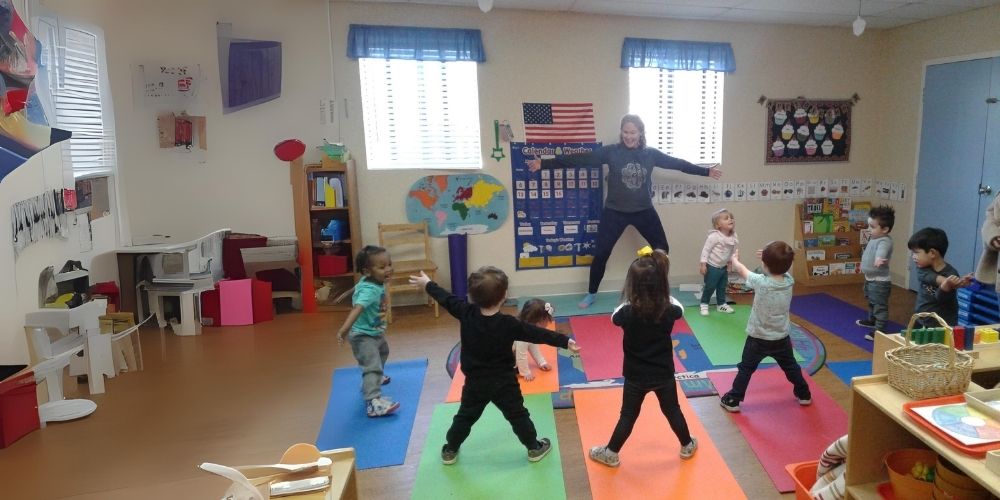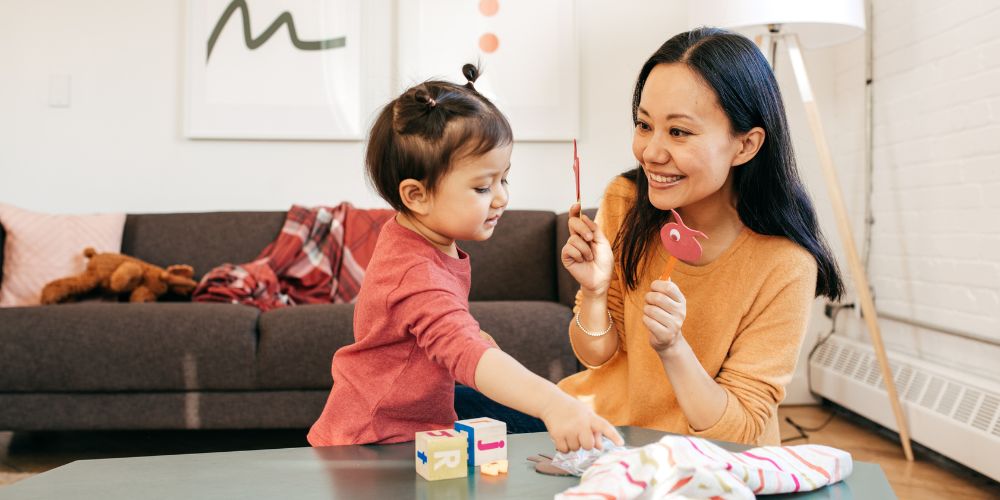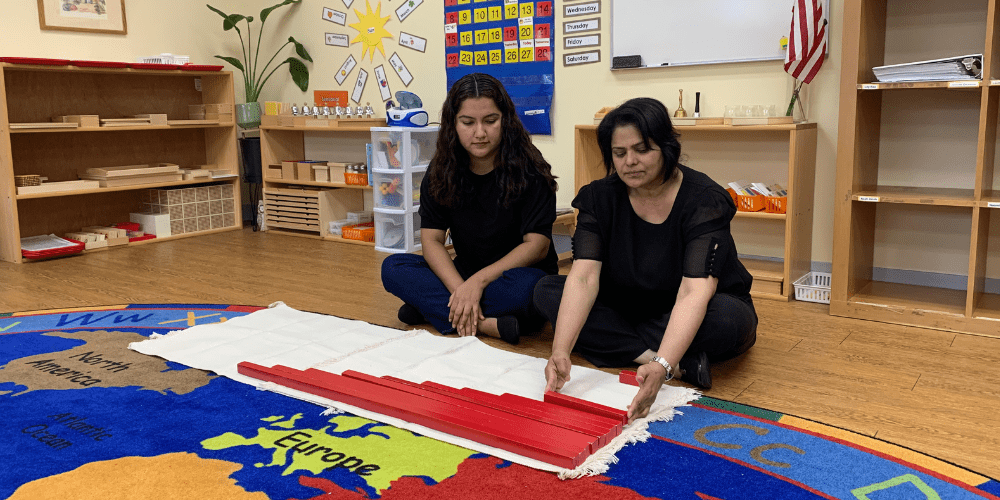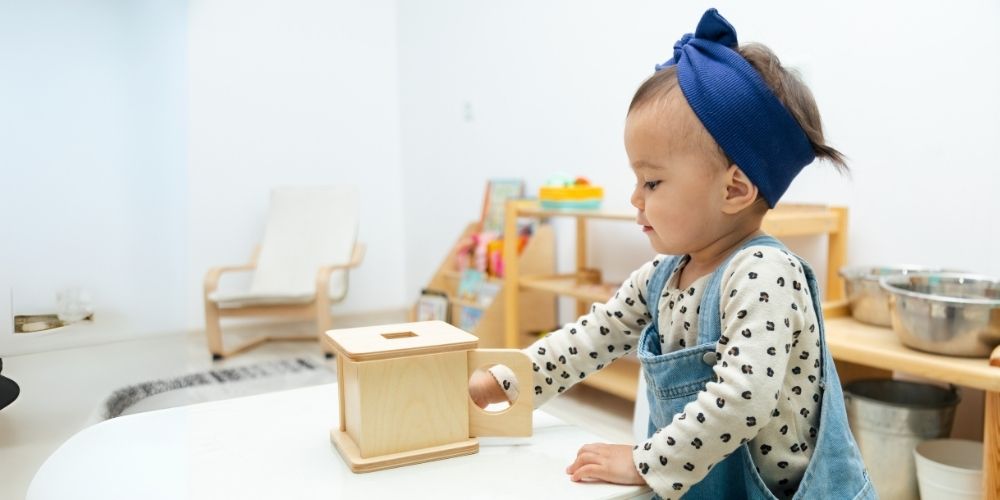If you ever find yourself in a Montessori classroom, you may notice quite a few differences from a traditional classroom structure. While traditional classrooms are run with a specific hierarchy led by teachers (often standing at the front of the room), Montessori classrooms are made up of many moving parts, including the teachers, students, materials and practices. These moving parts create a deliberate harmony that generates an ‘ecosystem’ unique to Montessori education. When students have fully settled into a Montessori classroom, they move freely around the room, happily choosing and completing tasks and activities that interest them. One of the hallmark practices that contributes to students adjusting to a classroom environment is the use of a mixed-age classroom.
Mixed-age classrooms, sometimes referred to as multi-age or mixed grade classrooms, is a format where classrooms are composed of students across more than one age or grade level. Instead of focusing on a specific age bracket, a mixed-age classroom focuses on development level and learning styles. The Montessori method embraces this format because of its proven ability to support individual student needs and inspire learning between differently aged students.
Individualized Approach Through Continuity
Traditional classroom formats operate under the assumption that children of the same age will learn at a complementary pace across all subject areas. This assumption that there is a set progression for students to follow can potentially leave advanced students stifled while others can fall behind if left without needed support. The Montessori method utilizes an individualized approach to learning early, allowing students to develop self-confidence and important problem-solving skills as they move through differing levels of work.
A major component in facilitating this success is continuity. In a mixed-age Montessori classroom model, children may remain in the same classroom for multiple years. This allows teachers more time to better understand their students’ needs and help them progress over time. Traditional classroom hierarchy requires teachers and students to spend the beginning of each academic year growing accustomed to each other’s respective teaching and learning styles. However, the Montessori method allows for teachers to pick up where they left off with their continuing students, resulting in nearly a month of extra, focused teaching time.
“I have had my teacher for two years, and the first time I came here I had to learn everything, but now I’m a Kindergartener and it’s my time to know what to do. My teachers help me with problems, but most of the time, I can do it by myself. ”- Pioneers student, age 5, on maintaining the same teacher.
Leading by Example
Grouping slightly older and younger children in the same classroom may not seem intuitive at first, but the roles they instinctively assume are very conducive to a productive learning environment. These classrooms naturally lead to peer-to-peer teaching moments, where older students are encouraged to assume leadership roles to develop their patience and empathy as they guide younger students through tasks they have already mastered. In turn, younger students are consistently taught by example and exposed to higher levels of maturity. Just as older children are encouraged to lead, younger children are encouraged to turn to older peers for guidance, ensuring they know how to ask for help and persevere with a difficult task in the years to come.
Outside of the individual interactions that a mixed-age classroom provides, a wider age group, for example ages 3-6, gives students a large-scale example of how determination will lead to progress, also known as a “growth mindset.” Younger students are able to see the possible results of their hard work applied over time by observing their older counterparts navigate the classroom with relative ease. For older students that may be struggling with specific skill sets that their similarly aged classmates have already acquired, they can follow the developmental trajectory of their younger classmates that are also still learning those specific skills, ensuring a student never feels left out or left behind.
Cooperation, Not Competition
The dynamic that a mixed-age classroom provides lends itself to a family-like atmosphere. With students supporting and guiding each other, they foster a spirit of cooperation and compassion. Students are not only emotionally invested in their own accomplishments, but also the accomplishments of others that they help facilitate. This is a stark contrast to the competition typically seen in traditional classrooms, where students are expected to achieve at the same level and will naturally compare themselves to one another. This comparison can lead to a decline in self esteem and academic performance.
The Montessori method focuses on the range of skills and abilities within a class, and celebrates student differences as assets. Children are exposed to a variety of talents and interests, as well as a range of maturity levels, and are able to see in practice the benefits of diversity. This prolonged exposure to a variety of strengths and weaknesses help students become comfortable collaborating with differently aged students, preparing them for the many similar real-life interactions to come in their academic and professional lives.
A Montessori education also teaches students that they are part of a larger whole, and that cooperation is vital to success. This collaborative process in the classroom can also benefit the family dynamic; the promotion of togetherness, rather than division, in mixed-age classrooms encourages harmony between siblings of varying ages at home. Students are able to absorb the concepts learned in their classroom and take ownership of their role and responsibilities within both their classroom and their household.
Mixed-Age Classrooms at CMMS
At Children’s Manor & Magnet Montessori Schools, we believe a mixed-age classroom is an invaluable asset to both students and their families. We offer a range of programs, from infant care to elementary school, that are based on the development of the whole child and support each student as they are. Students are evaluated on a case-by-case basis, rather than being assigned to a class based strictly on their ages. This allows us to become intimately familiar with each child’s strengths and challenges, so they can be placed in the classroom that will best support their needs and abilities. We believe in an academically rigorous yet supportive Montessori environment that encourages collaboration and exploration among our students across all ages and programs.
Our staff of qualified Montessori teachers are trained to prioritize continuity in the education of your child as they develop alongside their peers. Their personalized approach allows each student to advance at their own pace, regardless of their ability level, learning style, or social maturity. To learn more about our mixed-age programs and our staff expertise, be sure to visit childrensmagnet.com/programs. You can also learn more about our application of the Montessori method by scheduling a tour at the location of your choice.





